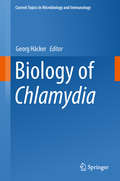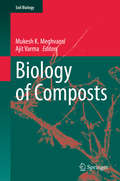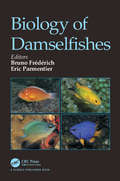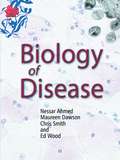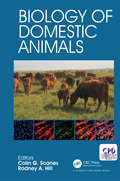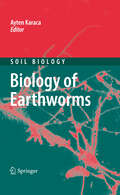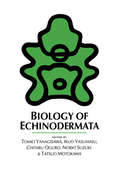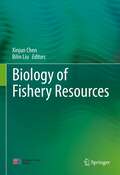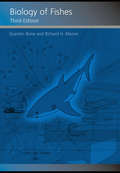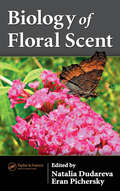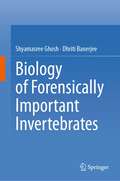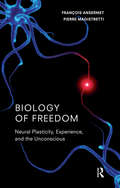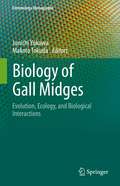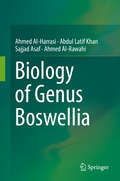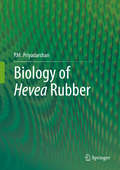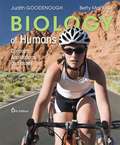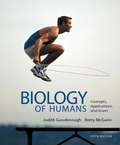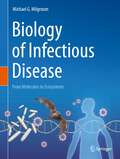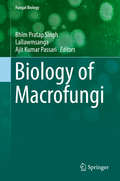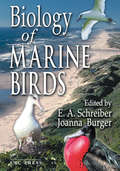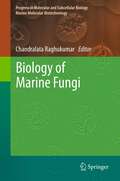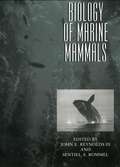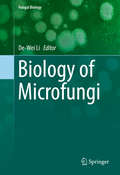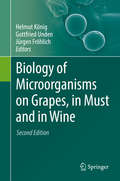- Table View
- List View
Biology of Chlamydia (Current Topics in Microbiology and Immunology #412)
by Georg HäckerThe genus Chlamydia encompasses a number of species of obligate intracellular bacteria, including important human pathogens like the most common bacterial agent of sexually transmitted disease. This volume reviews current knowledge of chlamydial biology, covering the unusual structure of the bacteria – which alternate between metabolically almost inactive and fast-dividing forms. It also discusses the ways in which Chlamydia manipulates the host cytoskeleton and subverts the host cell’s defence, and illustrates how genomics have begun to uncover the diversity and complexity of chlamydial strains that look very similar but may cause distinct forms of disease. Further, it describes how techniques are now finally being established that can genetically modify Chlamydia, and discusses why such modification is still very difficult and what progress we can expect. Lastly, it presents our current understanding of chlamydial disease: what do we know about chronic infections, what are the mechanisms of inflammatory damage, and what are the prospects of a vaccine? Written be specialists in these various areas, the book is a valuable work of reference for students and scientists with an interest in the molecular, cellular and immunobiology of these fascinating bacteria.
Biology of Composts (Soil Biology #58)
by Ajit Varma Mukesh K. MeghvansiThis book highlights the latest findings on fundamental aspects of composting, the interaction of various microorganisms, and the underlying mechanisms. In addition to addressing modern tools and techniques used for composting research, it provides an overview of potential composting applications in both agriculture and environmental reclamation.Composting is the process of organic waste decomposition, mediated by microorganisms. The end-product is called ‘compost’ and can be used as a supplement to improve soil fertility. As the municipal waste generated in most developing countries contains a substantial amount of organic matter suitable for composting, this technology offers a win-win opportunity for stakeholders in terms of disposing of organic waste and providing organic fertilizers for agriculture. In addition, using compost reduces the dependency on harmful chemical fertilizers, and represents a sustainable and environmentally friendly alternative.
Biology of Composts (Soil Biology Series #58)
by Ajit Varma Mukesh K. MeghvansiThis book highlights the latest findings on fundamental aspects of composting, the interaction of various microorganisms, and the underlying mechanisms. In addition to addressing modern tools and techniques used for composting research, it provides an overview of potential composting applications in both agriculture and environmental reclamation. Composting is the process of organic waste decomposition, mediated by microorganisms. The end-product is called ‘compost’ and can be used as a supplement to improve soil fertility. As the municipal waste generated in most developing countries contains a substantial amount of organic matter suitable for composting, this technology offers a win-win opportunity for stakeholders in terms of disposing of organic waste and providing organic fertilizers for agriculture. In addition, using compost reduces the dependency on harmful chemical fertilizers, and represents a sustainable and environmentally friendly alternative.
Biology of Damselfishes
by Bruno Frédérich Eric ParmentierDamselfishes (Pomacentridae) are highly conspicuous, diurnal inhabitants of mainly reef areas, capturing the attention of many scientists. Their high diversity and the many interesting characteristics dealing with their way of life (sound production, breeding biology, sex change, farming and gregarious behavior, settlement, diet, habitat) easily explain how this group is continually kept in the limelight and is the subject of numerous studies. This book gathers the data dealing with damselfish morphology, physiology, behavior, ecology and phylogeny.It contains 14 chapters written by renowned scientists.
Biology of Disease
by Chris Smith Ed Wood Nessar Ahmed Maureen DawsonBiology of Disease describes the biology of many of the human disorders and disease that are encountered in a clinical setting. It is designed for first and second year students in biomedical science programs and will also be a highly effective reference for health science professionals as well as being valuable to students beginning medical school. Real cases are used to illustrate the importance of biology in understanding the causes of diseases, as well as in diagnosis and therapy.
Biology of Domestic Animals
by Rodney A. Hill Colin G. ScanesThere is increasing interest in the biology of domestic animals ranging from genomics, transcriptomics, metabolomics, nutritional physiology, and systems biology. This book touches on all of these, with a particular focus on topics such as domestic animals as comparative models to humans, molecular regulation of growth, metabolic efficiency, reproduction, and the impact of stress on growth and development. The book concludes with a discussion on the current and future directions for researchers.
Biology of Earthworms (Soil Biology #24)
by Ayten KaracaEarthworms, which belong to the order Oligochaeta, comprise roughly 3,000 species grouped into five families. Earthworms have been called 'ecosystem engineers'; much like human engineers, they change the structure of their environments. Earthworms are very versatile and are found in nearly all terrestrial ecosystems. They play an important role in forest and agricultural ecosystems. This Soil Biology volume describes the various facets of earthworms, such as their role in soil improvement, soil structure, and the biocontrol of soil-borne plant fungal diseases. Reviews discuss earthworms' innate immune system, molecular markers to address various issues of earthworm ecology, earthworm population dynamics, and the influences of organic farming systems and tillage. Further topics include the characteristics of vermicompost, relationships between soil earthworms and enzymes, the role of spermathecae, copulatory behavior, and adjustment of the donated sperm volume.
Biology of Echinodermata
by T. YanagisawaThe proceedings of the Seventh International Echinoderm Conference, held at Atami, Japan, September 1990. In addition to sections covering ecology, evolution, reproduction, morphology, molecular biology, developmental biology, physiology, behavior, and paleontology, there are four plenary lectures a
Biology of Fishery Resources
by Xinjun Chen Bilin LiuThis auto-translation book overviews the fish population and its research methods, help readers in understanding the concept of fish population and population identification. It divides into seven chapters according to the characteristics of the subject and the development results. Based on a systematic introduction to the basic concepts and research contents of the biology of fishery resources, the book focuses on the introduction of fish populations and research methods, life history division and early development identification, age identification and growth research, the division of sexual maturity, the determination of reproductive habits and fecundity, feeding characteristics and research methods of fish, and the mechanism of fish colony and migration. Through the study of this course, we can master the basic theory and methods of fish biology research and lay a solid foundation for future researches on fishery resources. This book can be used as a reference book for undergraduates and postgraduates who study fishery resources, as well as for those who are engaged in fishery and marine research. The translation was done with the help of artificial intelligence (machine translation by the service DeepL.com). A subsequent human revision was done primarily in terms of content.
Biology of Fishes
by Richard Moore Quentin BoneThe VitalBook e-book version of Biology of Fishes is only available only in the US and Canada at the present time. To purchase or rent please visit http://store.vitalsource.com/show/978-1-1341-8631-0. The Third Edition of Biology of Fishes is chiefly about fish as remarkably efficient machines for coping with the many problems that life in wat
Biology of Floral Scent
by Eran Pichersky Natalia DudarevaAs with nearly all living creatures, humans have always been attracted and intrigued by floral scents. Yet, while we have been manufacturing perfumes for at least 5000 years to serve a myriad of religious, sexual, and medicinal purposes, until very recently, the limitation of our olfactory faculty has greatly hindered our capacity to clearly and ob
Biology of Forensically Important Invertebrates
by Shyamasree Ghosh Dhriti BanerjeeThis book emphasizes the important role of invertebrates in forensic sciences in the detection of crimes, determining the time and place of death, estimating the minimum Post-Mortem Interval (PMI), and determining the cause of death. The initial chapter discusses the forensically essential invertebrates, especially flies under Order Diptera. Further, the book highlights the importance, biology, taxonomy, and biodiversity of flies under Order Diptera with forensic importance. It also discusses the Cuticular HydroCarbons (CHC) and spectrometry-based studies reported from flies and larvae of forensic importance. It further reviews the importance of DNA barcoding in molecular taxonomy-based studies on forensic flies through understanding, identification, and grouping the organisms. Towards the end, this book presents the applications and limitations of forensic entomology in cases of animal cruelty to a veterinary professional.
Biology of Freedom: Neural Plasticity, Experience, and the Unconscious
by Francois Ansermet Pierre MagistrettiThis groundbreaking book delivers a much needed bridge between the neurosciences and psychoanalysis. Freud hoped that the neurosciences would offer support for his psychoanalysis theories at some point in the future: both disciplines, after all, agree that experience leaves traces in the mind. But even today, as we enter the twenty-first century, all too many scientists and analysts maintain that each side has wholly different models of the origin and nature of those traces. What constitutes human experience, how does this experience shape us, and how, if at all, do we change our lives? Psychoanalysis and the neurosciences have failed to communicate about these questions, when they have not been frankly antagonistic. But, in Biology of Freedom, Francois Ansermet and Pierre Magistretti are at last breaking new ground. This fully illustrated account, rigorous yet lucid and entirely accessible, shows how the plasticity of the brain's neural network allows for successive inscriptions, transcriptions, and retranscriptions of experience, leading to the constitution of an inner reality, an unconscious psychic life unique to each individual.
Biology of Gall Midges: Evolution, Ecology, and Biological Interactions (Entomology Monographs)
by Junichi Yukawa Makoto TokudaThis book provides practical ecological, ethological, evolutionary, and biogeographic data for gall-inducing cecidomyiids, their galls and host plants, based on field surveys, laboratory experiments and genetic analysis. It refers to various researches on gall-inducing insects published by a world of biologists. Practical methods of field surveys and data analysis are presented, as well as topics on parasitoids, invasive pests, and beneficial gall midges that would be useful for applied entomologists. Readers can learn an ecological way of thinking through diverse interrelations between insects and plants, and the analysis of ecological data from gall-inducing cecidomyiids. Galls can be easily observed in the field continuously from early to final stage of the development of galls and gall inducers because of their outstanding features and immobility. It provides important data of the host plant such as phenology, abundance as food resources, and the survival of galled organs. By taking these advantages, many biologists have used galls and gall-inducing insects as highly convenient organisms for a wide range of studies including ecology, ethology, evolution, and biogeography. The book primarily intends to present the appeal of galls and gall-inducing insects for various biological studies. In particular, gall-inducing cecidomyiids are ideal insects to study ecology and evolution. It helps to open the doors to further cryptic study subjects. Also, integrating various ecological, ethological, evolutionary and biogeographic data as shown in this book can serve to further advance the macroevolutionary studies of insects.
Biology of Genus Boswellia
by Ahmed Al-Harrasi Abdul Latif Khan Sajjad Asaf Ahmed Al-RawahiThis book provides insight into the biology and genomics of the genus Boswellia (family Burseraceae), a natural resource used for the production of frankincense, an oleo-gum resin. The Boswellia species are ecologically, medicinally, commercially and culturally important. Significantly contributing to the paucity of comprehensive literature on this genus, this volume provides a detailed discussion on the genomics, physiology and ecology of Boswellia. The chapters cover a wide range of topics, including taxonomy, distribution, genetic diversity and microbiology. The production process of frankincense and its impact on the species are presented as well. In light of the recent decline of various Boswellia populations, species propagation and conservation are discussed. Plant scholars, ecologists and conservation biologists will find this book to be an important and informative reference.
Biology of Hevea Rubber
by P. M. PriyadarshanRubber is an economically important material that occurs naturally and can be produced synthetically. Many advances have been made in the understanding of the cultivation and biology of the rubber tree, Hevea brasiliensis, and this book covers the essential elements of rubber breeding and physiology to provide a guide for cultivators and researchers of this vital crop. It provides an in-depth analysis of plant structure and crop physiology, climatic requirements, latex production, genetics and breeding. It also pays particular attention to biotechnology, molecular biology, soil tillage and crop establishment, nutrition, weed control, environmental and biological constraints, ancillary income generation and clean development management.
Biology of Humans: Concepts, Applications, and Issues (6th Edition)
by Judith Goodenough Betty A. McGuireFor courses in non-majors biology. Helps students learn the concepts and applications of human biology using relevant topics and realistic scenarios Known for its unique "Special Topic" chapters and emphasis on everyday health concerns, the 6th Edition of Biology of Humans: Concepts, Applications, and Issues continues to personalize the study of human biology using a conversational writing style, vibrant, easy-to-follow illustrations, abundant applications, and a new emphasis on using everyday science literacy skills. The authors provide a practical, friendly introduction to the study of the human body, preparing readers to navigate today's rapidly expanding and shifting world of health information. Each chapter now features brand-new "Consider This Case" exercises and "Finding and Evaluating Information" activities that challenge readers to think critically and apply their knowledge to solve real-world cases. Along with scientific updates and content improvements throughout the text, the 6th Edition also includes a new "Special Topic" chapter on the Obesity Epidemic.
Biology of Humans: Concepts, Applications and Issues, 5th Edition
by Betty Mcguire Judith GoodenoughEach chapter now opens with new “Did You Know?” questions that pique your interest with intriguing and little-known facts about the topic that follows. The Fifth Edition also features a new “Special Topic” chapter (1a) titled “Becoming a Patient: A Major Decision,” which discusses how to select a doctor and/or a hospital, how to research health conditions, and more.
Biology of Infectious Disease: From Molecules to Ecosystems
by Michael G. MilgroomThis textbook provides a broad introduction to the biological processes underlying infectious diseases in a range of hosts and pathogens. The text covers topics at all levels of biological organization, from the molecular and cellular level, organismal level, and population and ecosystem level, and goes well beyond infectious diseases of humans. The details of how microbes interact with their hosts are unique for each interaction, but emphasis is on the common principles of host-pathogen interactions that result in disease. Biology of Infectious Disease: From Molecules to Ecosystems is aimed at undergraduate and early graduate-level students in biology or public health, including pre-medical and pre-public-health students, who are interested in a broad introduction to infectious disease but do not have any previous background in microbiology or immunology.
Biology of Macrofungi (Fungal Biology)
by Bhim Pratap Singh Lallawmsanga Ajit Kumar PassariMushrooms are fleshy fungi with a high prospective for the production of secondary metabolites including extracellular enzymes with high agricultural and biotechnological significance. Worldwide, they are well recognized as supplementary foods due to their high nutritional values and their medicinal importance, which includes their uses in exhibiting antioxidant and antimicrobial activities, immune enhancer, and to be effective for the treatment of several diseases including diabetes and few types of cancers as well. According to recent studies, extracellular enzymes produced by several white-rot fungal strains such as Phanerochaete chrysosporium, Pleurotus sajor-caju and several mushrooms have shown a high capacity to decolorize dyes that are very harmful for the environment. Moreover, wild macrofungi have the capability to synthesize nanoparticles which are more useful for the treatment of cancer, gene therapy, DNA analysis and biosensors. Wild macrofungi are extremely important model for basic biology and commercial manufacture.
Biology of Marine Birds (CRC Marine Biology Series)
by Joanna Burger E. A. SchreiberBiology of Marine Birds provides the only complete summary of information about marine birds ever published. It analyzes their breeding biology, ecology, taxonomy, evolution, fossil history, physiology, energetics, and conservation. The book covers four orders of marine birds in detail and includes two summary chapters that address the biology of shorebirds and wading birds and their lives in the marine environment. Summary tables give detailed information on various aspects of their life histories, breeding biology, physiology and energetics, and demography. It provides a guide to ornithologists and students for research projects.
Biology of Marine Fungi (Progress in Molecular and Subcellular Biology #53)
by Chandralata RaghukumarThe diversity, ecological role and biotechnological applications of marine fungi have been addressed in numerous scientific publications in the last few years. This enormous spurt of information has led to a dire need among students and professionals alike for a source, which contains comprehensive reviews of various aspects of marine fungi. This book addresses this need, especially since it is written by reputed marine mycologists. The latest information on topics including molecular taxonomy and phylogeny, ecology of fungi in different marine habitats such as deep sea, corals, dead- sea, fungi in extreme marine environments and their biotechnological applications is reviewed. The book presents a comprehensive source of information and analysis aimed at marine fungi for researchers, teachers and students of marine mycology.
Biology of Marine Mammals
by John E. ReynoldsTaking an integrated approach to the biology of marine carnivores, cetaceans, and sirenians, twenty-two prominent researchers compare marine mammals with one another and with terrestrial mammals, providing a framework for fundamental biological and ecological concepts. They describe functional morphology, sensory systems, energetics, reproduction, communication and cognition, behavior, distribution, population biology, and feeding ecology. They also detail the physiological adaptations--for such activities and processes as diving, thermo-regulation, osmoregulation, and orientation--that enable marine mammals to exploit their aquatic environment.
Biology of Microfungi (Fungal Biology #0)
by De-Wei LiThis reference book includes 24 chapters written by a group of experts in the different fields of microfungi and cover a broad range of topics on microfungi. It provides the most updated information on the latest development in systematics and taxonomy of microfungi, new techniques which were developed in the last ten years and their application in microfungal research. After the International Code of Nomenclature for algae, fungi, and plants (Melbourne Code) was adopted by the Eighteenth International Botanical Congress Melbourne, Australia, July 2011, it has had a profound impact on mycology and its research. Fungal nomenclature changes and its significance to fungal taxonomy and naming of microfungi in the future is discussed in detail. Since dual names system for fungi developing both sexual and asexual states, and fungi developing only asexual state is no longer available, the first five chapters will clarify some confusion and provides perspective views on the direction for future research. The next nine chapters cover microfungi and their ecological roles or functions in the different habitats (air, indoor, aquatic, marine, plants, soils, etc). The remaining 13 chapters cover the relationship of microfungi and humans (good and bad) and usage or application microfungi in different industries, such as food, agriculture, forestry, green technology, pharmaceutics, and medicine, as well as in our daily life. The book bridges the gap between basic mycological research and applied mycology and provide readers a unique set of information and knowledge of microfungi generated from multiple angles in different fields of mycology.
Biology of Microorganisms on Grapes, in Must and in Wine
by Helmut König Gottfried Unden Jürgen FröhlichThe ancient beverage wine is the result of the fermentation of grape must. This n- urally and fairly stable product has been and is being used by many human societies as a common or enjoyable beverage, as an important means to improve the quality of drinking water in historical times, as therapeutical agent, and as a religious symbol. During the last centuries, wine has become an object of scientific interest. In this respect different periods may be observed. At first, simple observations were recorded, and subsequently, the chemical basis and the involvement of microorg- isms were elucidated. At a later stage, the scientific work led to the analysis of the many minor and trace compounds in wine, the detection and understanding of the biochemical reactions and processes, the diversity of microorganisms involved, and the range of their various activities. In recent years, the focus shifted to the genetic basis of the microorganisms and the molecular aspects of the cells, including metabolism, membrane transport, and regulation. These different stages of wine research were determined by the scientific methods that were known and available at the respective time. The recent "molecular" approach is based on the analysis of the genetic code and has led to significant results that were not even imaginable a few decades ago. This new wealth of information is being presented in the Biology of Microorganisms on Grapes, in Must, and in Wine.
